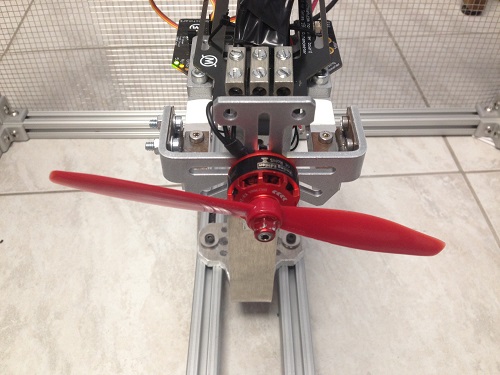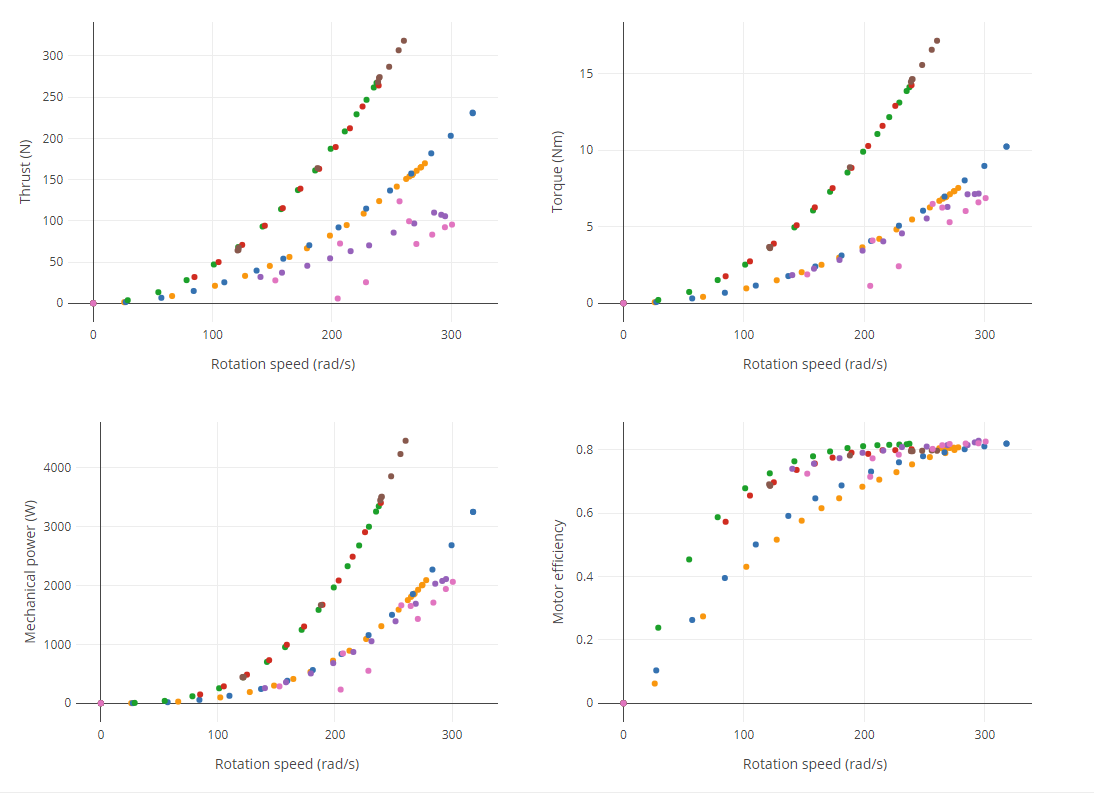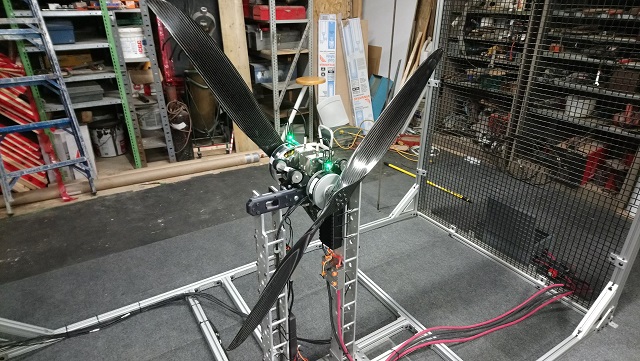I will discuss the challenges of designing this database. Searching for the right propulsion components for a UAV is tough. There is not much data available, and what is available from suppliers is not standardized or reliable. Even with the right tools, you still have to buy and test many components before finding the right motor and propeller. My team and I have extensive experience with dynamometers, so we have a good understanding of the issues, but we still had some serious challenges when designing a database.
 Racerstar BR2306S 2400kv and DALPROP 6040
Racerstar BR2306S 2400kv and DALPROP 6040
Dynamometer tests produce a lot of data. This data is very sensitive to the test conditions. The first obvious challenge in a user-contributed database is figuring out how to create a standardized test environment. There is, unfortunately, no international standard on propulsion test for small UAVs. I can say from personal experience with hundreds of businesses and universities that everyone does it differently. It is also not possible to record the entire test environment, so we cannot only use software checks. In the end, we came up with multiple solutions to minimize the variance between the test. First, we developed a strict test procedure and environment with a checklist. Second, all the tests are done with a script and uploaded automatically to minimize the risk of operator error. Third, the test script has multiple checks to test for data consistency. Finally, all the test data is available in the database and we encourage people to upload pictures and comments, so other users can verify the data accuracy and comment on it. We intend to implement a voting system so more people can help catch incorrect data.
Sample Data for the Xoar TA130-25 KV80
Another challenge is regarding sorting and categorizing the data. We developed a component-test model where each component can be associated with multiple tests, and multiple tests can be associated with multiple components. For example, this coaxial test has two motors and two propellers. If you click any of the components, you can see all the tests that were done with this component. This test-component model is important for data analysis. You can already see the data plotted on each component and test page, but it is possible to do more. We are working on an analysis module that will allow you to extract the fundamental motor and propeller parameters (Kv, i_0, C_t, C_p, etc…) from multiple tests. Those parameters will also be searchable.
The data in the database will always be freely accessible if contributors choose to make their data public. We are planning a model similar to GitHub where users pay only for private components hosting and analysis. We currently only support RCbenchmark test tools, but we are definitely open to supporting other tools if other people develop motor and propeller dynamometers.
Test of the Xoar Coaxial 47 and 40 inch prop
Next on our list of feature is display unit selection, advanced analysis and search, and an option to share embedded graphs on forums and websites. I invite you to browse the database and submit feedback! The database is still in alpha, so some features are missing, but it is already useable for searching, categorizing and data analysis.




Comments
Thanks a lot for sharing !
@Bart Theys, this brings me to another point: my aerodynamic knowledge might prove me wrong, but I'd think that the static thrust is different from what you'll get in flight. As such, one might consider measurements in a wind tunnel rather than static (or in flight)...
@Maxence, some years ago I did a limited set of tests to measure the influence of configuration, arm shape, push-pull and documented it in this paper.
There will always be a difference between the measured values on a bench with what we get when mounting it on a drone. And most of the time the drone will not be flying in perfect wind-still hover conditions.
Measuring thrust and torque in-flight is very difficult however...
Hi Maxence,
For 1 and 3 - We have done tests to evaluate the effect of the arm on the test results. There is no simple answer to the variability, unfortunately. Our protocol requires recording the test environment. I made a post about this subject here and here. Fun fact: using acrylic walls instead of mesh on the sides of the safety cage actually has a large effect on the test results!
2 - Yes, for this test, the tester did have the motor running backward. It will not affect the performance, but the nut could have become loose. The test was performed in a safety cage. The tester records the airflow direction and we ask to check and record the leading edge. We also encourage testers to take pictures to check for potential issues like the one you raised.
4 - Yes. The Series 1580 can record vibration and temperature. Pressure and hygrometry can be obtained from a local weather station and a thermometer, but it would be useful to have those sensor integrated in the future.
Until we (as an industry that includes motor manufacturers, propeller manufacturers, drone designers, test tool manufacturers, and end-users) come up with a standard test method, there will be some variability. Our protocol is an attempt at reducing the current test variability. I hope that we can refine the protocol as we record more tests. One issue is the large variability in the hardware and the lack of definition. For example, how do your record max. motor current? Is it max. current for 3, 30, 60, 300 seconds? At what temperature? With what kind of cooling should be used? How much lifespan reduction is accepted when running at max. current? There is also the issue of repeatability vs test cost. 0.1% repeatability would be great for designers, but it would be very expensive and almost no component would get tested as a result. I think there will be some kind of standard in a few years from now. We cannot establish a standard as a single actor in the industry, but we can publish suggested guidelines that will help to establish those standards.
Our database does not replace actual testing in the design process of a UAV, but it should reduce the number of tests required. The analysis tools of the database should also reduce the time required to analyze the data.
Hi Charles,
I really appreciate your job. I own a series of racerstar motors and I am glad that you began to test it.
Do you have a list of assumptions that you make before testing the power train?
I have some questions about your work and I will be glad to have your answers :
1 - The arm that support the motor does not really simulate drone arms, have you carried out tests with different arms and motor supports to take into account this disgression.
2 - On the photo referenced "Racerstar BR2306S 2400kv and DALPROP 6040", either you turn the engine in the opposite direction it is supposed to turn (and the nuts may unscrew) , or the propeller pushes the engine in its support, in which case, I think it would need a CCW and install it the other way, right?
3 - More generally, did you learn lessons about putting a motor in "push" or "pull" configuration?
4 - Finally, you said that "This data is very sensitive to test conditions", do you think that it could be useful to add some cheap measurment tools as, pressure, hygrometry, ambient temp, motor temp (with IR sensor) and maybe vibration and sound ?
See you soon.
Maxence.
@Wojciech Batog I understand your concern, and this is why we made the Series 1520: we started the company with hobbyists in minds. This is also partly why we made the database openly available: everyone can use it. The R&D costs for the tools are way too high to be paid for by hobbyists right now, but more options will be available in a few years. Thermal cameras were many thousands of dollars 10 years ago, and hundreds of thousands 30 years ago, but you can now buy a decent one for 250$.
This is a very good initiative. It is now very hard to find reliable thrust data for electric motors especially the larger ones.
It would be great if you could get some (preferably all) manufacturers to submit their data.
Unfortunately, I feel that your system is very cost prohibitive for private individuals (especially those outside US). The smallest stand (1520) is maybe makes some sense but its usability because of its size is limited. It would be nice to have a (thrust only?) 15kg max (max ~4kW?) stand sub $200 so one could test some of the lager motors.
At $4000 I just don't see it (for hobbyists).
Great initiative!